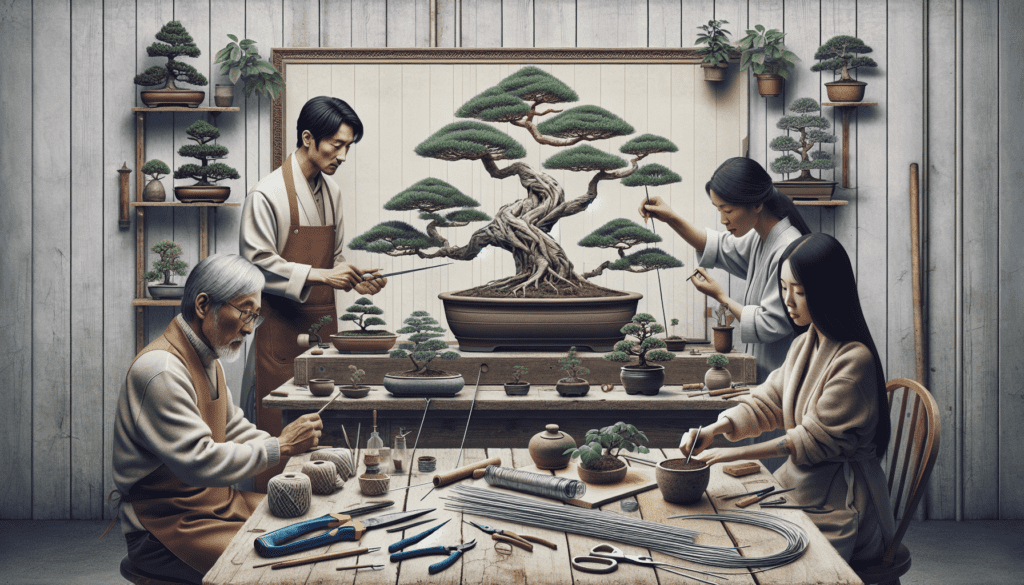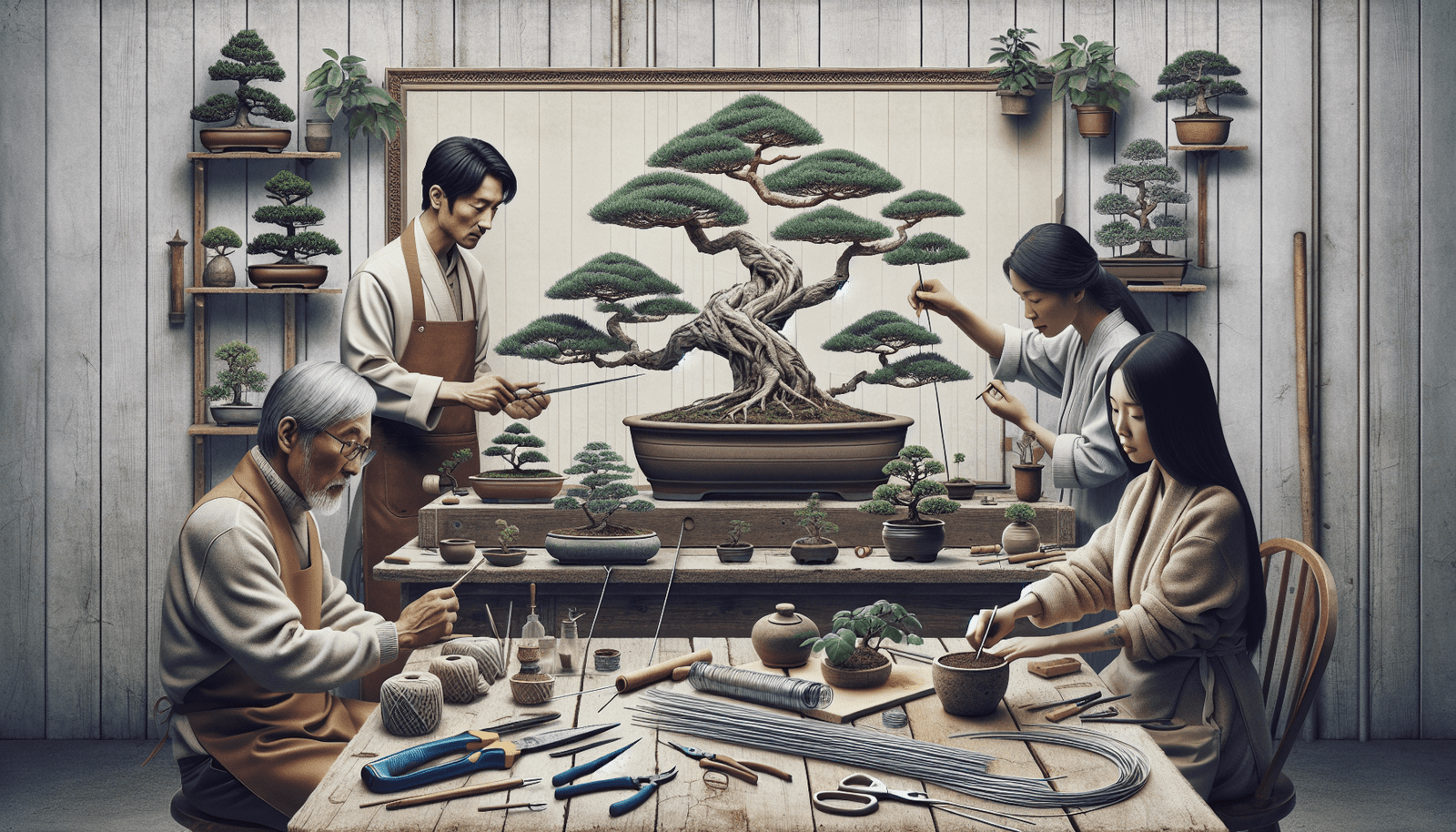Welcome to the fascinating world of Bonsai, where the ancient art of cultivating miniature trees has captured the hearts of many enthusiasts around the globe. Through patience, skill, and creativity, Bonsai artists create stunning living sculptures that reflect the beauty and harmony of nature in a small, but captivating way. Whether you are new to Bonsai or a seasoned hobbyist, exploring the techniques and history behind this traditional art form is sure to inspire and delight you. Have you ever been intrigued by the beauty and artistry of bonsai trees? These miniature trees have a rich history and cultural significance that make them a unique and rewarding hobby to cultivate. In this article, we will explore the art of bonsai, from its origins to the techniques used to care for these tiny marvels of nature. So, grab your pruning shears and let’s dive into the world of bonsai!
What is Bonsai?
Bonsai is an ancient Japanese art form that involves growing and cultivating miniature trees in containers. The word “bonsai” is derived from the Japanese words “bon” meaning tray and “sai” meaning planting. Bonsai trees are not genetically modified to stay small; rather, they are dwarfed through careful pruning, training, and root restriction.
Bonsai trees are not only visually appealing but also hold deep symbolic meanings in Japanese culture. They are often associated with harmony, balance, and tranquility, making them a popular choice for home decoration and gift-giving.
Why Bonsai?
Bonsai cultivation is more than just a gardening hobby; it is a meditative practice that requires patience, dedication, and creativity. The process of pruning and shaping a bonsai tree encourages mindfulness and a deeper connection with nature. It allows you to slow down, focus on the present moment, and appreciate the beauty of the natural world.
Bonsai trees also make great conversation starters and can be a unique and personalized gift for friends and family. Whether you are a seasoned gardener or a beginner looking to try something new, bonsai cultivation offers a rewarding and fulfilling experience.
Origins of Bonsai
The art of bonsai originated in China over a thousand years ago, where miniature landscapes known as “penjing” were created using dwarfed trees and rocks. These miniature landscapes were often displayed in ornate containers and showcased the natural beauty of the Chinese countryside.
Bonsai cultivation spread to Japan in the 12th century, where it evolved into the art form we recognize today. Japanese bonsai masters refined the techniques of pruning, wiring, and shaping trees to create intricate and lifelike miniature representations of full-size trees.
Japanese Influence
Japanese bonsai techniques prioritize the creation of balanced and harmonious compositions that reflect the beauty of nature. Japanese bonsai styles are classified based on the shape and structure of the tree, such as formal upright, informal upright, slanting, cascading, and semi-cascade.
The Japanese have also developed specific tools and materials for bonsai cultivation, such as pruning shears, wire cutters, bonsai wire, and specialized soil mixes. These tools are essential for maintaining the health and aesthetic appeal of bonsai trees.

Types of Bonsai Trees
There are several different types of trees that are commonly used for bonsai cultivation, each with its own unique characteristics and requirements. Some popular species of bonsai trees include:
Juniper
Juniper bonsai trees are known for their rugged and gnarled trunks, which give them a weathered and ancient appearance. Junipers are hardy trees that can withstand various growing conditions, making them an excellent choice for beginners.
Ficus
Ficus bonsai trees are characterized by their glossy leaves and aerial roots, which give them a tropical and exotic look. Ficus trees are easy to care for and can adapt well to different environments, making them a popular choice for indoor bonsai cultivation.
Pine
Pine bonsai trees are prized for their elegant and delicate needles, which create a sense of tranquility and serenity. Pines require ample sunlight and well-drained soil to thrive, making them a challenging but rewarding choice for experienced bonsai enthusiasts.
Maple
Maple bonsai trees are known for their vibrant fall foliage and delicate branching patterns, which make them a breathtaking sight to behold. Maples require consistent watering and protection from strong winds to maintain their health and beauty.
Elm
Elm bonsai trees are valued for their small leaves and graceful branching structure, which create a sense of elegance and refinement. Elms are resilient trees that can survive various pruning techniques and styles, making them a versatile choice for bonsai cultivation.
Bonsai Cultivation Techniques
Cultivating a healthy and beautiful bonsai tree requires a combination of artistry, skill, and patience. There are several techniques that bonsai enthusiasts use to shape and maintain their trees, including:
Pruning
Pruning is the process of removing excess growth from a bonsai tree to maintain its shape and balance. Regular pruning helps promote new growth and prevents the tree from becoming overgrown or misshapen. Pruning should be done carefully and selectively to avoid damaging the tree’s branches and foliage.
Wiring
Wiring is a technique used to bend and shape the branches of a bonsai tree into different configurations. Bonsai wire is wrapped around the branches and trunk of the tree to guide their growth and create an artistic silhouette. Wiring should be done with caution and removed once the branches have set into the desired position.
Repotting
Repotting is a crucial aspect of bonsai cultivation that refreshes the tree’s soil and root system. Bonsai trees should be repotted every 2-5 years to prevent root-bound growth and promote healthy root development. Repotting should be done in the spring or fall when the tree is dormant to minimize stress and maximize growth.
Watering
Watering is essential for maintaining the health and vitality of a bonsai tree. Bonsai trees should be watered regularly to keep the soil moist but not waterlogged. The frequency of watering depends on the species of the tree, the size of the pot, and the environmental conditions. Overwatering and underwatering can both be detrimental to the tree’s health, so it is essential to monitor the soil moisture carefully.
Fertilizing
Fertilizing provides essential nutrients to bonsai trees that promote growth, flowering, and overall health. Bonsai trees should be fertilized regularly during the growing season with a balanced fertilizer that contains nitrogen, phosphorus, and potassium. Overfertilizing can lead to nutrient imbalances and root burn, so it is crucial to follow the manufacturer’s instructions and recommendations.

Bonsai Styles and Techniques
There are several traditional bonsai styles and techniques that bonsai enthusiasts use to create diverse and visually striking compositions. Each style emphasizes different aspects of bonsai cultivation, such as symmetry, movement, and balance. Some popular bonsai styles include:
Formal Upright
The formal upright style features a straight trunk that tapers gradually from the base to the apex. The branches are evenly spaced and display a balanced and harmonious appearance. Formal upright bonsai trees evoke a sense of strength, stability, and elegance.
Informal Upright
The informal upright style features a slightly curved trunk that twists and turns as it ascends towards the apex. The branches are asymmetrical and create a sense of movement and dynamism. Informal upright bonsai trees convey a natural and organic aesthetic that mimics the growth patterns of wild trees.
Slanting
The slanting style features a trunk that leans at an angle to create a sense of motion and energy. The branches follow the curvature of the trunk and create a dynamic and captivating silhouette. Slanting bonsai trees evoke a sense of resilience, determination, and adaptability.
Cascading
The cascading style features a trunk that cascades downwards like a waterfall, creating a sense of grace and fluidity. The branches hang below the pot and create a cascading effect that mimics the growth patterns of trees in nature. Cascading bonsai trees evoke a sense of tranquility, movement, and elegance.
Forest
The forest style features multiple trees planted together in a single container to create a miniature forest landscape. The trees vary in height and shape to create a sense of depth and perspective. Forest bonsai trees evoke a sense of community, harmony, and interconnectedness.
Bonsai Care Tips
Caring for a bonsai tree requires attention to detail and conscientious maintenance to ensure its health and vitality. Here are some essential tips for caring for your bonsai tree:
Light
Bonsai trees require ample sunlight to perform photosynthesis and thrive. Place your bonsai tree in a sunny location where it can receive at least 4-6 hours of direct sunlight each day. Rotate the tree periodically to ensure even growth and prevent it from leaning towards the light source.
Temperature
Bonsai trees are sensitive to extreme temperatures and fluctuations, so it is essential to keep them in a stable and protected environment. Most bonsai trees prefer daytime temperatures between 60-80°F and nighttime temperatures between 50-65°F. Protect your bonsai tree from frost, heatwaves, and drafts that can stress the tree and hinder its growth.
Watering
Watering is critical for maintaining the health and hydration of your bonsai tree. Check the soil moisture daily by inserting a finger into the soil to gauge its dampness. Water your bonsai tree when the soil feels slightly dry to the touch, ensuring that the water reaches all parts of the root system. Use a watering can with a fine rose attachment to water the tree gently and prevent soil erosion.
Humidity
Bonsai trees require adequate humidity to prevent their leaves from wilting and drying out. Place a humidity tray filled with water and pebbles underneath the bonsai tree to create a microclimate that increases humidity levels. Mist the leaves of your bonsai tree regularly with a spray bottle to maintain moisture and prevent dehydration.
Pruning
Pruning is essential for shaping and maintaining the health of your bonsai tree. Use sharp pruning shears to remove dead, damaged, or overgrown branches and foliage. Prune the tree selectively to maintain its shape and balance while promoting new growth. Avoid pruning more than one-third of the tree’s foliage at once to prevent stress and shock.
Fertilizing
Fertilizing provides essential nutrients to your bonsai tree that promote growth and vitality. Use a balanced liquid fertilizer diluted to half strength and apply it to the soil every 2-4 weeks during the growing season. Reduce fertilization in the fall and winter when the tree is dormant to prevent nutrient buildup and root burn.
Repotting
Repotting is a crucial aspect of bonsai care that refreshes the soil and root system of your tree. Repot your bonsai tree every 2-5 years in the spring or fall when the tree is dormant. Gently remove the tree from its pot, trim the roots, and repot it in fresh bonsai soil to promote healthy growth. Water the tree thoroughly after repotting to reduce stress and encourage recovery.
Pest Control
Pests such as aphids, spider mites, and scale insects can infest your bonsai tree and damage its foliage and branches. Inspect your tree regularly for signs of pests, such as yellowing leaves, sticky residue, or webbing. Treat infestations with insecticidal soap, neem oil, or natural predators to eliminate pests and prevent reinfestation. Avoid using harsh chemicals that can harm the tree and disrupt its ecosystem.
Conclusion
The art of bonsai is a fascinating and rewarding hobby that offers a unique opportunity to connect with nature and cultivate miniature masterpieces. Whether you are a seasoned bonsai enthusiast or a beginner looking to try something new, bonsai cultivation provides a creative outlet for self-expression and mindfulness.
By learning about the history, techniques, and styles of bonsai cultivation, you can deepen your appreciation for these captivating miniature trees and enjoy the meditative process of caring for them. So, roll up your sleeves, grab your tools, and start your bonsai journey today. Remember, the art of bonsai is not just about growing trees; it’s about nurturing your passion, creativity, and connection to the natural world. Happy bonsai growing!

